
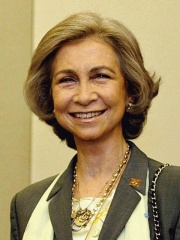
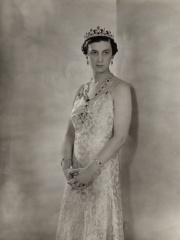

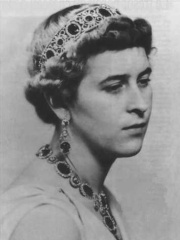
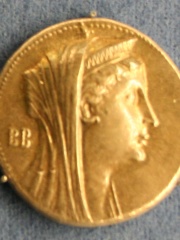
The Most Famous
NOBLEMEN from Greece
This page contains a list of the greatest Greek Noblemen. The pantheon dataset contains 1,415 Noblemen, 7 of which were born in Greece. This makes Greece the birth place of the 21st most number of Noblemen behind United States, and Norway.
Top 7
The following people are considered by Pantheon to be the most legendary Greek Noblemen of all time. This list of famous Greek Noblemen is sorted by HPI (Historical Popularity Index), a metric that aggregates information on a biography's online popularity.

1. Prince Philip, Duke of Edinburgh (1921 - 2021)
With an HPI of 82.77, Prince Philip, Duke of Edinburgh is the most famous Greek Nobleman. His biography has been translated into 114 different languages on wikipedia.
Prince Philip, Duke of Edinburgh (born Prince Philip of Greece and Denmark, later Philip Mountbatten; 10 June 1921 – 9 April 2021), was the husband of Queen Elizabeth II. As such, he was the consort of the British monarch from his wife's accession on 6 February 1952 until his death in 2021, making him the longest-serving royal consort in history. Philip was born in Greece into the Greek and Danish royal families; his family was exiled from the country when he was eighteen months old. After being educated in France, Germany, and the United Kingdom, he joined the Royal Navy in 1939, when he was 18 years old. In July 1939, Philip began corresponding with the 13-year-old Princess Elizabeth, the elder daughter and heir presumptive of King George VI. During the Second World War, he served with distinction in the British Mediterranean and Pacific fleets. In the summer of 1946, the King granted Philip permission to marry Elizabeth, then aged 20. Before the official announcement of their engagement in July 1947, Philip stopped using his Greek and Danish royal titles and styles, became a naturalised British subject, and adopted his maternal grandparents' surname Mountbatten. In November 1947, he married Elizabeth, was granted the style His Royal Highness and was created Duke of Edinburgh, Earl of Merioneth, and Baron Greenwich. Philip left active military service when Elizabeth ascended the throne in 1952, having reached the rank of commander. In 1957, he was created a British prince. Philip had four children with Elizabeth: Charles, Anne, Andrew, and Edward. A sports enthusiast, Philip helped develop the equestrian event of carriage driving. He was patron, president, or member of over 780 organisations, including the World Wide Fund for Nature, and served as chairman of The Duke of Edinburgh's Award, a youth awards programme for people aged 14 to 24. Philip is the longest-lived male member of the British royal family. He retired from royal duties in 2017, aged 96, having completed 22,219 solo engagements and 5,493 speeches since 1952, and died two months before his 100th birthday at Windsor Castle.

2. Queen Sofía of Spain (b. 1938)
With an HPI of 78.97, Queen Sofía of Spain is the 2nd most famous Greek Nobleman. Her biography has been translated into 53 different languages.
Sofía (Sophia Margarita Victoria Frederica; Greek: Σοφία Μαργαρίτα Βικτωρία Φρειδερίκη, romanized: Sofía Margaríta Victoría Freideríki; born 2 November 1938) is a member of the Spanish royal family who was Queen of Spain from 1975 to 2014 as the wife of King Juan Carlos I until his abdication. She is the eldest child of King Paul and Queen Frederica of Greece. Sofía married then Infante Juan Carlos of Spain in 1962 and became queen of Spain upon her husband's accession in 1975. On 19 June 2014, Juan Carlos abdicated in favour of their son Felipe VI. Since her spouse's abdication, Doña Sofía has usually been referred to as reina emérita ('queen emerita') by the press.

3. Princess Marina of Greece and Denmark (1906 - 1968)
With an HPI of 75.71, Princess Marina of Greece and Denmark is the 3rd most famous Greek Nobleman. Her biography has been translated into 35 different languages.
Princess Marina of Greece and Denmark (Greek: Μαρίνα; 13 December [O.S. 30 November] 1906 – 27 August 1968), later Duchess of Kent, was a Greek and Danish princess by birth and a British princess by marriage. A granddaughter of King George I of Greece and Queen Olga, she was the daughter of Prince Nicholas of Greece and Denmark and Grand Duchess Elena Vladimirovna of Russia. In 1934, she married Prince George, Duke of Kent, the fourth son of King George V and Queen Mary. They had three children: Edward, Alexandra, and Michael. She was widowed in 1942, when her husband was killed in a plane crash while on active service, and remained active in royal duties throughout her later life, attending public engagements across the Commonwealth, including the independence celebrations for Ghana and Botswana. She died in 1968, aged 61.

4. Leotychidas (540 BC - 469 BC)
With an HPI of 70.41, Leotychidas is the 4th most famous Greek Nobleman. His biography has been translated into 29 different languages.
Leotychidas II (Ancient Greek: Λεωτυχίδας; Doric: Λατυχίδας Latychidas; c. 545 – c. 469 BC) was king of Sparta from 491–476 BC, alongside Cleomenes I and later Leonidas I and Pleistarchus. He led Spartan forces during the Persian Wars from 490–478 BC. Born in Sparta around 545 BC, Leotychidas was a descendant of the Royal House of the Eurypontids (through Menamus, Agesilaus, Hippocratides, Leotychides, Anaxilaus, Archidamos, Anaxandridas I and Theopompus) and came to power in 491 BC with the help of the Agiad King Cleomenes I by challenging the legitimacy of the birth of Demaratus for the Eurypontid throne of Sparta. Later that year, he joined Cleomenes's second expedition to Aegina, where ten hostages were seized and given to Athens. However, after Cleomenes's death in 488 BC, Leotychidas was almost surrendered to Aegina. In the spring of 479 BC, following the death of his co-ruler Leonidas at the Battle of Thermopylae, Leotychidas commanded a Greek fleet consisting of 110 ships at Aegina and later at Delos, supporting the Greek revolts at Chios and Samos against Persia. Leotychidas defeated Persian military and naval forces at the Battle of Mycale on the coast of Asia Minor in the summer of 479 BC (possibly around mid-August). In 476 BC, Leotychidas led an expedition to Thessaly against the Aleuadae family for collaboration with the Persians but withdrew after being bribed by the family. Upon returning to Sparta he was tried for bribery, and fled to the temple of Athena Alea in Tegea. He was sentenced to exile and his house burned. He was succeeded by his grandson, Archidamus II, son of his son Zeuxidamus, called Cyniscus, who had died in his father's lifetime. Leotychidas died some years later, around 469 BC.
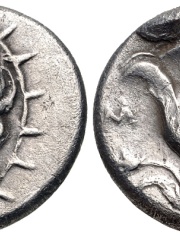
5. Memnon of Rhodes (380 BC - 333 BC)
With an HPI of 68.39, Memnon of Rhodes is the 5th most famous Greek Nobleman. His biography has been translated into 28 different languages.
Memnon of Rhodes (Greek: Μέμνων ὁ Ῥόδιος; c. 380 – 333 BC) was a prominent Rhodian Greek commander in the service of the Achaemenid Empire. Related to the Persian aristocracy by the marriage of his sister to the satrap Artabazus II, together with his brother Mentor he served the Persian king for most of his life, and played an important role in the empire's defence during the invasion of Alexander the Great, in particular at the Siege of Halicarnassus, and even the decades before that. Carl Otis Schuster notes that though often inaccurately described as "simply a mercenary", Memnon was arguably the toughest defender of the Persian Empire Alexander had to face, and was nearly successful in putting a halt to him.

6. Princess Sophie of Greece and Denmark (1914 - 2001)
With an HPI of 67.33, Princess Sophie of Greece and Denmark is the 6th most famous Greek Nobleman. Her biography has been translated into 31 different languages.
Princess Sophie of Greece and Denmark (Greek: Σοφία, romanized: Sofía; 26 June 1914 – 24 November 2001) was by birth a Greek and Danish princess, as well as a princess of Hesse-Kassel and a princess of Hanover through her successive marriages to Prince Christoph of Hesse and Prince George William of Hanover. An elder sister of Prince Philip, Duke of Edinburgh (husband of Queen Elizabeth II), she was, for a time, linked to the Nazi regime. The fourth of five children of Prince Andrew of Greece and Denmark and Princess Alice of Battenberg, Sophie spent a happy childhood. Her early years, however, were affected by the First World War (1914–1918) and the Greco-Turkish War (1919–1922), leading to the family's exile in Switzerland (between 1917 and 1920), and then in France (from 1922 to 1936). During their exile, Sophie and her family depended on the generosity of their foreign relatives, in particular Marie Bonaparte (who offered them accommodation in Saint-Cloud) and Lady Louis Mountbatten (who supported them financially). At the end of the 1920s, Sophie fell in love with one of her distant cousins, Prince Christoph of Hesse. Around the same time, her mother had a mental health crisis which led to her confinement in a Swiss psychiatric hospital between 1930 and 1933. Married in December 1930, Sophie moved to Berlin with her husband. She then gave birth to five children. Close to the Nazi circles, in which her husband and several of her in-laws were involved from 1930, Sophie joined the National Socialist Women's League in 1938. Sophie and her in-laws served as unofficial intermediaries between Nazi Germany and the European dynasties to which they were related. Christoph and Sophie moved into a large house located in Dahlem, in 1936. The outbreak of the Second World War, however, forced the couple to separate; Sophie moved with her children to her mother-in-law at Friedrichshof Castle in Kronberg im Taunus. Adolf Hitler's growing distrust of the German aristocracy (from 1942) and the betrayal of King Victor Emmanuel III of Italy (in 1943) led the Nazi regime to turn against the House of Hesse-Kassel. Princess Mafalda, daughter of the Italian monarch and sister-in-law of Sophie, was imprisoned in Buchenwald, where she was seriously wounded and died shortly after, while her husband, Philipp, Landgrave of Hesse, was confined in Flossenbürg until the victory of the Allies. At the same time, Christoph was found dead in mysterious circumstances, leaving Sophie almost alone with her four children and a fifth one on the way, as well as the children of Philipp and Mafalda. The tragic events made Sophie turn against Nazism. The defeat of Germany and its occupation by the Allies brought new difficulties in the life of Sophie, who found herself in a precarious financial situation due to the theft of her jewelry by American soldiers in 1946 and the sequestration of the property of her first husband until 1953. After living for several months in Wolfsgarten, she began a relationship with another cousin, Prince George William of Hanover, whom she married in 1946. She had three more children by her second husband. The couple moved to Salem, where George William worked as director of Schule Schloss Salem (1948–1959), before settling in Schliersee (from 1959). Excluded from the 1947 wedding of her brother Prince Philip to Princess Elizabeth of the United Kingdom (later Queen Elizabeth II) because of her past links to the Nazi regime, Sophie was reintegrated into the royal circles in the early 1950s. She nevertheless led a discreet and withdrawn life, spending her time reading, listening to music and gardening. The last surviving sibling of the Duke of Edinburgh, she died in a retirement home in Schliersee in 2001. She was the paternal aunt of the Prince of Wales, who later became King Charles III.

7. Arsinoe I (305 BC - 248 BC)
With an HPI of 67.09, Arsinoe I is the 7th most famous Greek Nobleman. Her biography has been translated into 36 different languages.
Arsinoe I (Ancient Greek: Ἀρσινόη, 305 BC – after c. 248 BC) was queen of Egypt by marriage to Ptolemy II Philadelphus.
People
Pantheon has 7 people classified as Greek noblemen born between 540 BC and 1938. Of these 7, 1 (14.29%) of them are still alive today. The most famous living Greek noblemen include Queen Sofía of Spain. The most famous deceased Greek noblemen include Prince Philip, Duke of Edinburgh, Princess Marina of Greece and Denmark, and Leotychidas.
Living Greek Noblemen
Go to all RankingsDeceased Greek Noblemen
Go to all RankingsPrince Philip, Duke of Edinburgh
1921 - 2021
HPI: 82.77
Princess Marina of Greece and Denmark
1906 - 1968
HPI: 75.71
Leotychidas
540 BC - 469 BC
HPI: 70.41
Memnon of Rhodes
380 BC - 333 BC
HPI: 68.39
Princess Sophie of Greece and Denmark
1914 - 2001
HPI: 67.33
Arsinoe I
305 BC - 248 BC
HPI: 67.09
Overlapping Lives
Which Noblemen were alive at the same time? This visualization shows the lifespans of the 3 most globally memorable Noblemen since 1700.

